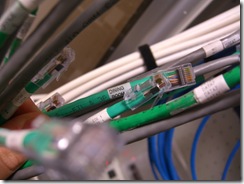Wiring the house for a Home Network - Part 6 - Identifying Performance Factors of Home Gigabit Networks
 Here's the colophon for my home wiring series. Everything is working great. Here's what I learned.
Here's the colophon for my home wiring series. Everything is working great. Here's what I learned.
- Cat 6 was very likely overkill for my house, but I still feel better doing it and would do it again, if only for the sense of future-proofness (future-proofocity?) that I have. Cat 5e would very likely have been fine, but the difference in cost was minimal.
- I should have got a wiring closet that was twice as wide as what I got. My closet is large by home standards - it's 4 feet tall - but it's cramped. It's not as tidy as the ones you see in the literature because I used my own switch. Unfortunately it's a 1U switch so it's ridiculously Velcro-ed to the back of the panel, making the whole thing look kind of less-than-sanitary.
- Once you get a really reliable wireless router, don't ever flash the firmware, or even look at it crooked. I've got a new Verizon FIOS ActionTec router and it's rock solid. It's perfect. It's so good I'm shocked how bad the original old one I had was. The wireless performance is stellar and complete, with coverage throughout the whole house (it's a big house). The signal is strong and every single laptop - even the ones that I thought of as finicky - connect perfectly to it. If you're having wireless problems, it's probably your router.
- WPA (AES) is a nice simple and very secure way to setup your wireless if you've got Vista or Mac clients throughout. I am also able to get my Wii and PSP hooked up to the wireless easily. Seriously, take the time and give up on WEP and go update your whole house to WPA today.
- Unless you're like me, a 100 megabit network is likely all you need and you'll probably not max its bandwidth out. It was very challenging to get a file copy to 60-80 megs a second and how often does one do that really? My network runs between 0% and 1% utilization. ;) That said, I'm still happy it's done.
Tim Heuer pointed me to Anthony Park's blog today as he's done a VERY VERY detailed analysis of Identifying Performance Factors of Home Gigabit Networks with a in-depth PDF explaining their methodology. They did 192 different scenarios and the conclusion is amazing enough that you have to read it for yourself.
Anyway, here's the full series of posts on home wiring so far:
Enjoy.
About Scott
Scott Hanselman is a former professor, former Chief Architect in finance, now speaker, consultant, father, diabetic, and Microsoft employee. He is a failed stand-up comic, a cornrower, and a book author.
About Newsletter
Once you get a really reliable wireless router, don't ever flash the firmware, or even look at it crooked.
Amen. I had an Actiontec router.DLS modem from Qwest and it started acting up. I downloaded their firmware update and it bricked it. Luckily they had a firmware restoration program included on the disk. If they hadn't included that, I never would have tried to flash the firmware. Ended up just using the Qwest router just in modem mode and getting a Linksys. No problems since.
I have never had a firmware flashing go smoothly.
I know that MAC addresses can be spoofed but honestly I've always just used MAC address lockdown as my primary security gate. Aside from the little bit of trouble in rounding up MAC addresses associated with your devices is there any reason you stick to WPA?
If people come by that want to use the wireless it's as simple as connecting to the router and adding them to the table.
Thoughts?
Thanks for the great posts!
Kurt
If people come by that want to use the wireless it's as simple as connecting to the router and adding them to the table.
That's fine when you're home, but what about when you're out and your wife's father comes to the house with his laptop?
[ring ring]
"Hey my dad just came over and he can't get online."
"OK honey, just log into http://192.168.1.1 with username "admin" and password "f*(3nd*HnF", and click on these five nested menu items, and then on your dad's computer hold the start key and press "R", then type "cmd", then in that black box type "IPCONFIG /all", now look at the MAC... yeah you may need to scroll up, yup that's it, now type that into--"
[dial tone]
"Hello?"
Never forget latency! The 1000mbit network has less latency than the 100mbit, and THAT people will notice! The throughput is nice, but its faster even on lots of tiny transfers. This gives it that faster "feel".
http://catalog.belkin.com/IWCatProductPage.process?Product_Id=273526
Thanks,
Mehfuz
Comments are closed.

Are you using Vista and Server 2008? The problem with network utilization being so low isn't the network, it's the protocol. Vista / Server 2008 (only working together) can take advantage of SMB 2.0. I highly recommend that any new network be GigE.
The article is dated 2006, but surprisingly Microsoft still left this feature in both Vista and Server 2008:
http://technet.microsoft.com/en-us/library/bb726965.aspx